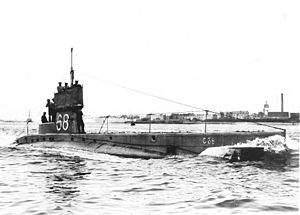Loading AI tools
Submarine of the Royal Navy From Wikipedia, the free encyclopedia
HMS C7 was one of 38 C-class submarines built for the Royal Navy in the first decade of the 20th century. The boat survived the First World War and was sold for scrap in 1920.
 HMS C38 - a typical C-class submarine | |
| History | |
|---|---|
| Name | HMS C7 |
| Builder | Vickers, Barrow |
| Laid down | 9 December 1905 |
| Launched | 15 February 1907 |
| Commissioned | 23 May 1907 |
| Fate | Sold for scrapping, 20 December 1919 |
| General characteristics | |
| Class and type | C-class submarine |
| Displacement |
|
| Length | 142 ft 3 in (43.4 m) |
| Beam | 13 ft 7 in (4.1 m) |
| Draught | 11 ft 6 in (3.5 m) |
| Installed power | |
| Propulsion |
|
| Speed |
|
| Range | 910 nmi (1,690 km; 1,050 mi) at 12 kn (22 km/h; 14 mph) on the surface |
| Test depth | 100 feet (30.5 m) |
| Complement | 2 officers and 14 ratings |
| Armament | 2 × 18 in (450 mm) bow torpedo tubes |
The C class was essentially a repeat of the preceding B class, albeit with better performance underwater. The submarine had a length of 142 feet 3 inches (43.4 m) overall, a beam of 13 feet 7 inches (4.1 m) and a mean draft of 11 feet 6 inches (3.5 m). They displaced 287 long tons (292 t) on the surface and 316 long tons (321 t) submerged. The C-class submarines had a crew of two officers and fourteen ratings.[1]
For surface running, the boats were powered by a single 16-cylinder 600-brake-horsepower (447 kW) Vickers petrol engine that drove one propeller shaft. When submerged the propeller was driven by a 300-horsepower (224 kW) electric motor.[1] They could reach 12 knots (22 km/h; 14 mph) on the surface and 7 knots (13 km/h; 8.1 mph) underwater. On the surface, the C class had a range of 910 nautical miles (1,690 km; 1,050 mi) at 12 knots (22 km/h; 14 mph).[2]
The boats were armed with two 18-inch (45 cm) torpedo tubes in the bow. They could carry a pair of reload torpedoes, but generally did not as they would have to remove an equal weight of fuel in compensation.[3]
C7 was built by Vickers at their Barrow-in-Furness shipyard, laid down on 9 December 1905 and was commissioned on 23 May 1907. The boat is often mistakenly credited with sinking UC-68 on 5 April 1917 off the coast of The Netherlands. However, this attack was made against UB-10, which survived.[4] C7 was sold on 20 December 1919.
Seamless Wikipedia browsing. On steroids.
Every time you click a link to Wikipedia, Wiktionary or Wikiquote in your browser's search results, it will show the modern Wikiwand interface.
Wikiwand extension is a five stars, simple, with minimum permission required to keep your browsing private, safe and transparent.